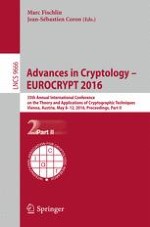2016 | OriginalPaper | Chapter
Structural Lattice Reduction: Generalized Worst-Case to Average-Case Reductions and Homomorphic Cryptosystems
Authors : Nicolas Gama, Malika Izabachène, Phong Q. Nguyen, Xiang Xie
Published in: Advances in Cryptology – EUROCRYPT 2016
Publisher: Springer Berlin Heidelberg
Activate our intelligent search to find suitable subject content or patents.
Select sections of text to find matching patents with Artificial Intelligence. powered by
Select sections of text to find additional relevant content using AI-assisted search. powered by
